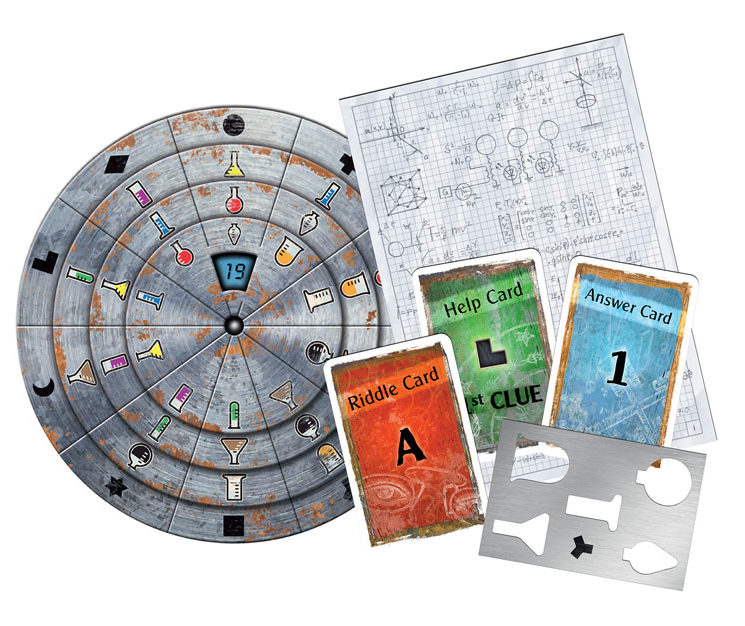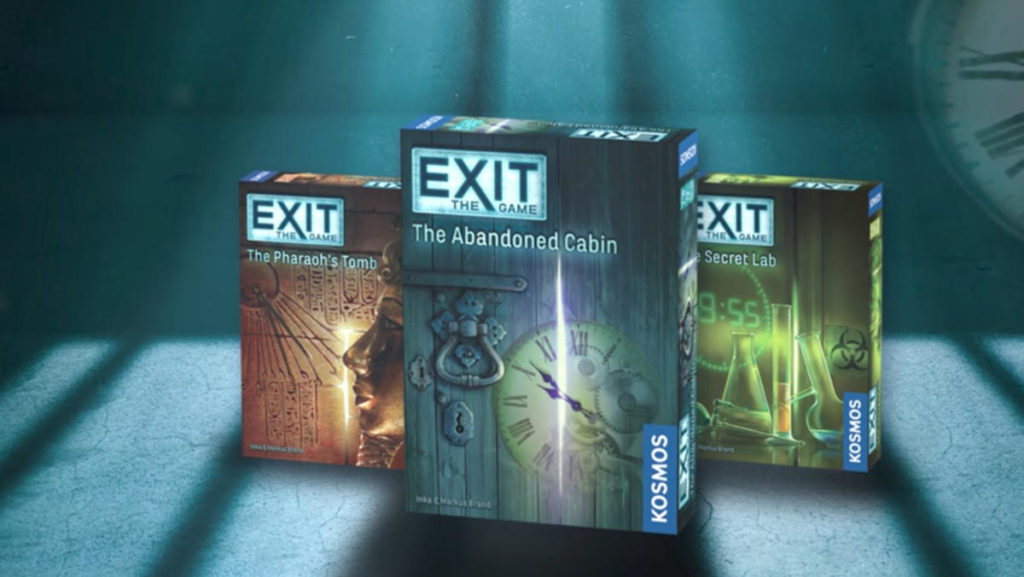Exit: The Game (An Escape Room in a box)
 Escape Rooms have been growing in popularity and fans now have a way to have a similar experience in their own home. Several companies have released an “Escape Room in a Box” style game that provides an Escape Room experience through a consumable game. (As you play, the components are destroyed.) Just this week, Exit: The Boardgame, was honored as one of the two “Games of the Year” in Germany. Today we’ll take a look (without spoilers) at one of the Escape Room options, Exit: The Game.
Escape Rooms have been growing in popularity and fans now have a way to have a similar experience in their own home. Several companies have released an “Escape Room in a Box” style game that provides an Escape Room experience through a consumable game. (As you play, the components are destroyed.) Just this week, Exit: The Boardgame, was honored as one of the two “Games of the Year” in Germany. Today we’ll take a look (without spoilers) at one of the Escape Room options, Exit: The Game.
Exit: The Game
Publisher: Kosmos
Ages: 12+
Players: 1-6
Time: 1-2 hrs
(Review copy provided by Kosmos)
Every version of Exit: The Game (there are 3 so far, more on the way,) comes in a small box containing three sets of cards (riddles, hints and answers), a clue pamphlet, a couple paper “items”, and a decoder disk. The game background is read aloud from the pamphlet and then the timer is started and play begins. The group’s “score” is the length of time needed to “escape” with extra time added for each hint used. The basic idea is for players to figure out the answer to a puzzle card, check to see if it is correct using the code wheel and looking in the answer stack, which typically then leads to more puzzle cards.

The game contains about 10 different puzzles, each identified with a specific symbol. Many of the clues and pictures are identified by this symbol so you know which clue you are working on. When you think you have completed a puzzle, you “dial in” your answer on the puzzle wheel. This is a paper object made of three “stacked” discs (one on top of another) of various symbols with a window on the inner ring. To solve a puzzle, you line up your guess of the three object solution and check the inner window. (In our game, the each wheel had 10 different colored “potions”, so we might dial in “red, green, green”.) This will lead you to a numbered card in the answer stack. Check the backside of (only) this card and it will tell you if the clue is incorrect. Some answer cards will instead point you to a second card in the stack. In either case, you will be told if you have found the correct solution or not. If you are successful, the solution card will typically tell you to pull out one or more new puzzle cards. Some puzzle cards are simply pieces to another puzzle while others offer up a challenge in and of themselves. In our game we even encountered a “new room” on one of the cards, containing the start of several new puzzles.
If you get stuck, there is a set of three clue cards for each of the puzzles. The first clue usually just tells you what you need to have on hand to solve the puzzle (you may not have encountered everything you need yet) including what section of the pamphlet might be useful. The second clue goes into more detail for what you have to do, while the third clue is simply the answer. In our game we used one or two of the first clues, and it looked to me that the second clue card should be enough for all but the thorniest of problems.
The game continues until you complete the final puzzle, after which the timer is stopped and the game is “scored.” I like to think our group was fairly intelligent and we managed to solve our room in 90 minutes using two help cards (probably only needed one…) Doing the whole thing in 60 minutes with no clues would have been “10 stars.” The game includes a page for you to write in all the people who worked on the problem and the total score.
As you play, players are encouraged to write down and mark on various bits and pieces and even go so far as to cut apart things in order to more easily solve some puzzles. This means that the game will be modified and marked up by the time you finish. You won’t need to play it again, since you now know all the answers; but you won’t be able to give it away to a friend either as the cards and papers will be all marked/cut up. This brings us to the main complaint my friends raised about the game. They understood the game wasn’t going to be replayed but it severely irked them that the leftovers now needed to be thrown away. The cards and most of the other bits are made from nice glossy paper, something that isn’t easily recycled. Ironically, they would have liked to see the game on LESS expensive paper, something that could be recycled once done. I had accepted the “consumable” idea of the game right from the start, but could see their concern.

Verdict: Exit: The Game
Fifteen or so dollars (the cost of the small box) is a great deal for a fun evening of play. Aside from the recycling concerns, we thoroughly enjoyed our play. Some of the puzzles seemed tricky. There were high fives all around when we solved them. One or two others (or at least parts of one or two others) seemed a bit too obvious. For a group of 10 total puzzles I figure that is about as good as one might expect.
The age range of 12+ is pretty good, although 10 or 11 year old kids who enjoy puzzles would find ways to contribute. We played with a group of 4 players and that seemed just about the right number of players. I wouldn’t want to play with more, as I felt the progression of the evening favored a somewhat linear progression through the puzzles. We were typically all working on the same puzzle with a few occasions where there were two going at the same time. If there were any more people I suspect some would be left out or find it hard to have a good view of the puzzle bits and pieces. The game could be played solo, but I think it would then miss out on the nice social interaction.
All in all, I liked the game. The cooperative nature and continual positive feedback (as we solved things) made for a fun evening. Once you can get past the idea of buying a “one-use” boardgame, the game will provide plenty of bang for your buck. With its recent “Game of the Year” award, expect to see many more versions of Exit: The Game coming down the pipeline. (Three more this fall, with six more coming next year.)





Discussion Area - Leave a Comment